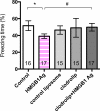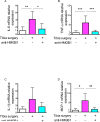High-mobility group box 1 protein initiates postoperative cognitive decline by engaging bone marrow-derived macrophages
- PMID: 24162463
- PMCID: PMC3999217
- DOI: 10.1097/ALN.0000000000000045
High-mobility group box 1 protein initiates postoperative cognitive decline by engaging bone marrow-derived macrophages
Abstract
Background: Aseptic trauma engages the innate immune response to trigger a neuroinflammatory reaction that results in postoperative cognitive decline. The authors sought to determine whether high-mobility group box 1 protein (HMGB1), an ubiquitous nucleosomal protein, initiates this process through activation and trafficking of circulating bone marrow-derived macrophages to the brain.
Methods: The effects of HMGB1 on memory (using trace fear conditioning) were tested in adult C57BL/6J male mice; separate cohorts were tested after bone marrow-derived macrophages were depleted by clodrolip. The effect of anti-HMGB1 neutralizing antibody on the inflammatory and behavioral responses to tibial surgery were investigated.
Results: A single injection of HMGB1 caused memory decline, as evidenced by a decrease in freezing time (52 ± 11% vs. 39 ± 5%; n = 16-17); memory decline was prevented when bone marrow-derived macrophages were depleted (39 ± 5% vs. 50 ± 9%; n = 17). Disabling HMGB1 with a blocking monoclonal antibody, before surgery, reduced postoperative memory decline (52 ± 11% vs. 29 ± 5%; n = 15-16); also, hippocampal expression of monocyte chemotactic protein-1 was prevented by the neutralizing antibody (n = 6). Neither the systemic nor the hippocampal inflammatory responses to surgery occurred in mice pretreated with anti-HMGB1 neutralizing antibody (n = 6).
Conclusion: Postoperative neuroinflammation and cognitive decline can be prevented by abrogating the effects of HMGB1. Following the earlier characterization of the resolution of surgery-induced memory decline, the mechanisms of its initiation are now described. Together, these data may be used to preoperatively test the risk to surgical patients for the development of exaggerated and prolonged postoperative memory decline that is reflected in delirium and postoperative cognitive dysfunction, respectively.
Figures





Comment in
-
Is it appropriate to use fear conditioning to assess behavior impairment in fracture rat models?Anesthesiology. 2014 Dec;121(6):1353. doi: 10.1097/ALN.0000000000000452. Anesthesiology. 2014. PMID: 25405301 No abstract available.
-
In reply.Anesthesiology. 2014 Dec;121(6):1353-4. doi: 10.1097/ALN.0000000000000453. Anesthesiology. 2014. PMID: 25405302 No abstract available.
References
-
- Abildstrom H, Rasmussen LS, Rentowl P, Hanning CD, Rasmussen H, Kristensen PA, Moller JT. Cognitive dysfunction 1-2 years after non-cardiac surgery in the elderly. ISPOCD group. International Study of Post-Operative Cognitive Dysfunction. Acta Anaesthesiol Scand. 2000;44:1246–51. - PubMed
-
- Moller JT, Cluitmans P, Rasmussen LS, Houx P, Rasmussen H, Canet J, Rabbitt P, Jolles J, Larsen K, Hanning CD, Langeron O, Johnson T, Lauven PM, Kristensen PA, Biedler A, van Beem H, Fraidakis O, Silverstein JH, Beneken JE, Gravenstein JS. Long-term postoperative cognitive dysfunction in the elderly ISPOCD1 study. ISPOCD investigators. International Study of Post-Operative Cognitive Dysfunction. Lancet. 1998;351:857–61. - PubMed
Publication types
MeSH terms
Substances
Grants and funding
LinkOut - more resources
Full Text Sources
Other Literature Sources
Medical
Research Materials

